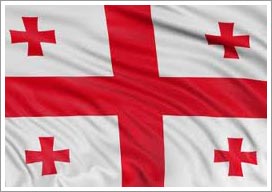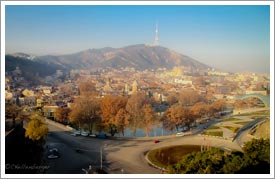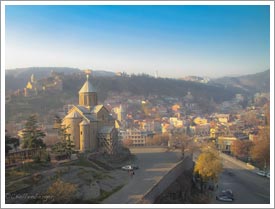History of Georgia
The history of Georgia involves many historical records of battles for statehood and independence, interspersed with brief interludes of peace. Throughout the long years of war and chaos, Georgia as a country has not only survived and retained a strong European cultural flavor, but its people have demonstrated their strength of will and independence in keeping their country and culture intact and utterly unique in every sense of the word.
The history of this fascinating country is quite extensive, and it could take months to have a full understanding of its history. Condensed into an abridged version, here are the highlights of Georgia’s ancient and modern history.
HISTORY OF ANCIENT GEORGIA
GEORGIA B.C.
As one of the most ancient cultures in the world, the people of Georgia and the earliest occupation of present day Georgia dates back 1.8 million years ago. This is clear from the excavations of Dmanisi in the southeastern part of the country, while later prehistoric remains (Acheulian, Mousterian and the Upper Palaeolithic) can be found in various caves and open-air sites in Georgia.
The earliest agricultural Neolithic occupation, known as the Shulaveri-Shomu culture, existed between 5000 and 6000 B.C. These people used local obsidian for tools, raised animals such as cattle and pigs, and grew crops, including grapes. (Image of Old Tbilisi by Carrie Kellenberger)
The Land of the Golden Fleece
Georgian history can be traced back to the ancient kingdoms of Colchis and Iberia. In the 4th century, it was one of the first countries to adopt Christianity. The cult of Mithras and Zoroastrianism were prevalently practiced in Iberia from the 1st centuries AD, before the adoption of Christianity.
In ancient Greek mythology, Colchis was the location of the Golden Fleece. In Apollonius Rhodius’ epic tale Argonautica, Jason and the Argonauts stole the Golden Fleece from King Aeetes with the help of his daughter Medea. Remote mountain villagers in Svaneti (a part of ancient Colchis) had the local practice of using sheepskins to trap the fine gold particles in the rivers that flowed from the Caucasus Mountains. The skins would then be dried and beaten to shake out their contents. It is still debated whether or not the legendary “wealth” of Colchis referred only to gold.
In the 4th- 6th centuries, the Georgians fought against Persian and Byzantine conquerors in order to maintain independence. Egrisi was repelling the Byzantines and Kartli (the Iberians) the Persians. At the end of the 5th century, Prince Vakhtang I Gorgasali initiated an anti-Persian uprising and he restored Iberian statehood by proclaiming himself as the King. However, his struggle for the independence and unity of the Georgian state did not produce long lasting effects. The King of Kartli (Iberia) fell in battle early in the 6th century and after his death the Iranians began to act zealously. Yet, this time the Iberian nobility were given the privilege of electing the governors, who in Georgian were called erismtavari. By the late 7th century, the Byzantine-Persian struggle for the Middle East led to Arab conquest of the region.
The first decades of the 9th century saw the rise of new Georgian state in Tao-Klarjeti. These included the Principalities of Tao and Klarjeti, the Earldoms of Shavsheti, Khikhata, Samtskhe, Trialeti, Javakheti and Ashotsi, which were formally a part of the Byzantine Empire, under the name of “Curopalatinate of Iberia”. However, in reality this region functioned as a fully independent country with its capital in Artanuji.
The first united Georgian monarchy was formed at the end of the 10th century when Curopalate David invaded the Earldom of Kartli-Iberia.
In 1008-1010, Bagrat occupied Kakheti and Ereti, therefore becoming the first king of a united Georgia in both the east and the west.
Georgia reached the peak of its political and economic strength during the rein of King David and Queen Tamar in the 11th and 12th centuries. The second half of the 11th century depicts the strategically significant invasion of the Seljuk Turks. By the end of the 1040s they had built a nomadic empire, which included most of central Asia and Persia. By 1081, all of Armenia, Anatolia, Mesopotamia, Syria and most of Georgia had been conquered and devastated by the Seljuks.
Today, archaeological excavations persist with the hope of understanding more of Georgian history and the influences of Ancient Greek colonization of the Black Sea area.
HISTORY OF MODERN GEORGIA
Russian Rule
In 1783, Russia and the eastern Georgian Kingdom of Kartli-Kakheti signed the Treaty of Georgievsk, which recognized the bond of Orthodox Christianity between the people of Russia and Georgia. It also promised eastern Georgia protection. Despite this commitment to defend Georgia, however, Russia offered no assistance when the Turks and Persians invaded in 1785 and 1795, completely destroying Tbilisi and massacring its inhabitants.
Between 1801 and 1918 the country of Georgia was part of the Russian Empire. Russian and Georgian societies had much in common, which involved two main focus points: the main religion of both countries was Orthodox Christianity and both regions had a land-owing nobility that ruled over a population of villains. At first the Russian authorities intended to integrate Georgia into the rest of the Empire, but Russian rule soon proved to be too domineering and aloof to the local customs and ideals of the Georgian people. This led to a conspiracy by the Georgian elite in 1832 and a revolution by villains and elite in 1841.
Georgia was annexed by the Soviet Union in 1921. From 1922 to 1991 the Georgian Soviet Socialist Republic (SSR) was one of fifteen federal republics of the Soviet Union. Georgia suffered from civil unrest and economic crisis for most of the 1990s and up to 2003, when a new government introduced democratic and economic reforms.
Events took a different turn when Mikhail Semyonovich Vorontsov came into office as Viceroy of the Caucasus in 1845. Count Vorontsov’s new administration strategies successfully attracted the Georgian elite, who became progressively Europeanized. The prospect of a decent life was still very shallow, as rural economy remained in a debased state. Many Georgians lived in deplorable poverty, vulnerable to the exposure to starvation on a daily basis. Some of them resided in towns, where the meager trade and industry that existed there was in the hands of Armenians, whose forefathers had voyaged to Georgia in the Middle Ages.
Declaration of Independence
Georgia declared independence on May 26, 1918 in the midst of the Russian Civil War. The Georgian Social-Democratic Party won the parliamentary election, and their leader, Noe Zhordania, became prime minister.
Georgia’s independence did not last long. In 1918, a Georgian-Armenian war erupted in parts of Georgia that were populated mostly by Armenians. Later that year, Georgian general Giorgi Mazniashvili led an attack against the White Army in order to claim the Black Sea coastline. Georgia fell under British protection from 1918-1920.
View of Tbilisi by Carrie Kellenberger
Georgia and the Soviet Union
The Red Army attacked Georgia in February 1921. The Georgian Army was defeated and the Social-Democratic government fled the country. The Red Army entered Tbilisi on February 25, 1921 and installed a Moscow directed communist government. Russian rule, however, was not firmly established until after a 1924 revolt was brutally suppressed. Georgia was then incorporated into the Transcaucasian SFSR alongside Armenia and Azerbaijian.
During World War II, almost 700,000 Georgians fought in the Red Army against Nazi Germany.
The Dissidential movement for restoration of Georgian statehood started to gain popularity in the 1960s.
A peaceful anti-Soviet demonstration in Tbilisi on April 9, 1989, ended in the deaths of 20 Georgians killed by Soviet troops. Its legacy served to radicalize Georgia opposition to Soviet power. On the second anniversary of the tragedy, the Supreme Council of the Republic of Georgia proclaimed Georgian independence and sovereignty from the Soviet Union.
Zviad Gamsakhurdia was elected as the first President of independent Georgia on May 26, 1991. He was soon overthrown in a seizure of power that lasted from December 22, 1991 to January 6, 1992. Georgia then became embroiled in a bitter civil war that lasted until the end of 1994.
In 1995, the people of Georgia elected a new president, Eduard Shevardnadze. Disputes between local separatists and the majority Georgian populations within Abkhazia and South Ossetia, however, erupted into inter-ethnic violence and wars. Supported by Russia, the two regions eventually achieved independence from Georgia. Many Ossetian families were forced to abandon their homes in the Borjomi region and move to Russia during that period of time.
In 2003, President Shevardnadze was deposed by the Rose Revolution, after accusations that the November 2 parliamentary elections had been marred by fraud. Following the Rose Revolution, a series of reforms were launched to strengthen Georgia’s military and economic capabilities. The new government’s effots to reassert Georgian authority in the southwestern republic of Ajaria led to a crisis in 2004. These events, along with accusations of Georgian involved in the Second Chechen War and Russia’s open assistance to two secessionists areas, led to a breakdown of relations with Russia. Russia withdrew all personnel and equipment at Russian bases in Batumi and Akhalkalaki were withdrawn in December 2007.
A military conflict between Georgia on one side and Russia, along with the separatist republics of South Ossentia and Abkhazia occurred in 2008. Georgian forces began a large scale military attack on the South Ossentian capital of Tskhinvali on August 7, 2008. Georgian forces were defeated and forced to regroup at Gori. They were then forced to retreat to Tbilisi. Shortly after their retreat, Russian forces entered Tbilisi and occupied many villages unopposed. President Medvedev announced his intent to halt further Russian military operations in Georgia on August 12. Russian troops withdrew from Gori and Poti, but remained in South Ossentia and Abkhazia, which it recognized as independent countries. Georgia, on the other hand, still considers these territories to be under Russian occupation.




